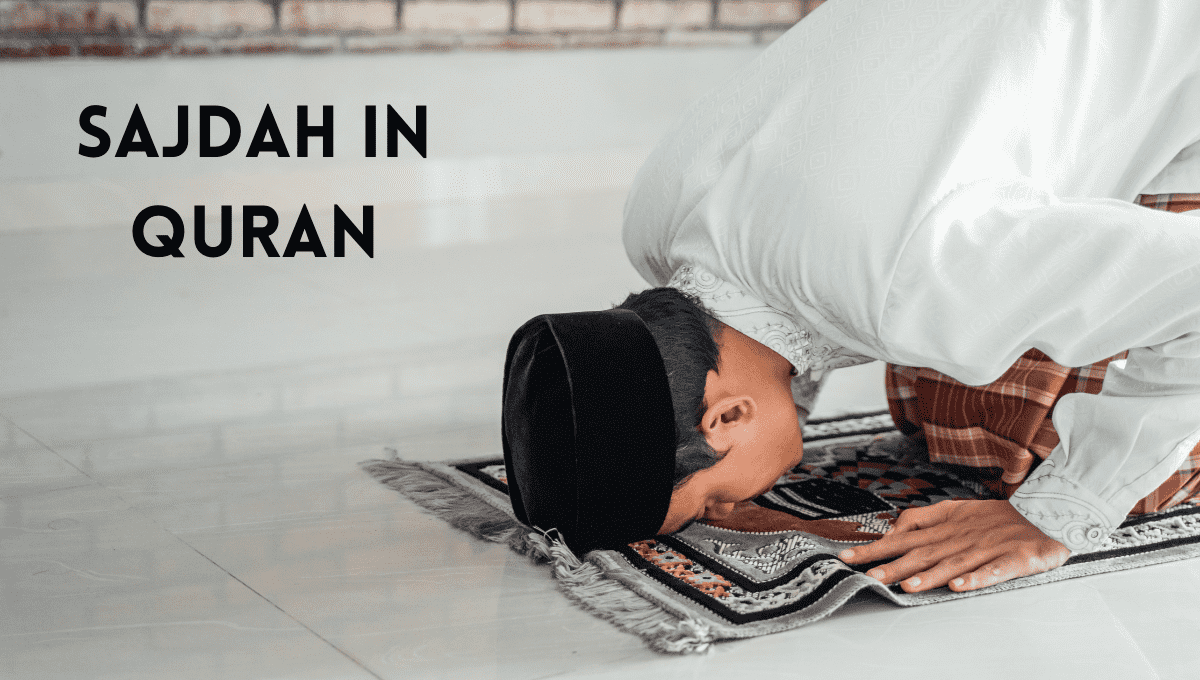
Sajdah in the Quran
In Arabic, “Sajdah” directly means “prostration.” However, in the realm of Islam and its holy scripture, Sajdah in Quran goes beyond just a physical gesture of bowing or placing one’s forehead on the ground. It epitomizes deep surrender and humility. It symbolizes a profound submission, humility, and devotion towards Allah. Sajdah is one of the most emblematic gestures in Islamic worship.
Understanding the Significance of Sajdah in Quran.
Definition
Sajdah denotes the act of bowing down in reverence, with the forehead, nose, hands, knees, and toes making contact with the ground.
Importance
Beyond its physical execution, Sajdah epitomizes the essence of a Muslim’s relationship with Allah. It signifies the ultimate act of submission, emphasizing that a believer acknowledges the grandeur and supremacy of the Almighty. This action demonstrates relinquishing one’s ego and pride, positioning oneself in the most humble stance before God.
Classifying the Various Forms of Sajdah
In the Islamic practice, Sajdah in Quran is more than just a singular concept. Different types of Sajdah exist, each carrying its unique significance and instances for performance.
Sajdah Tilawat
Meaning and Significance:
- The term ‘Tilawat’ translates to ‘recitation.’ Sajdah Tilawat refers to the prostration performed upon the recitation or hearing of specific verses from the Quran that have the instruction or indication for a prostration. These verses are specially marked in the Quran.
- The act immediately responds to God’s word, indicating reverence, respect, and acknowledgement.
Spiritual Implications:
Performing the Sajdah Tilawat brings the believer closer to God. It serves as a momentary pause to absorb the gravity of the verses and reflect upon their profound meanings.
Sajdah of Thanksgiving (Shukr)
Occasions and Reasons to Perform:
- Sajdah Shukr is executed when a Muslim wants to show gratitude to Allah for a particular blessing, mercy, or favour.
- Common instances include receiving good news, being saved from a calamity, or witnessing a miracle.
Spiritual Implications:
This Sajdah in Quran emphasizes the believer’s conscious acknowledgement of God’s mercies. It reinforces the idea that all blessings, big or small, come from Allah and thus should be recognized with gratitude.
Sajdah of Obedience (Ta’at)
Understanding its Role in Worship:
Sajdah Ta’at is deeply embedded within the five daily Salah (prayers) that Muslims perform. It represents the pinnacle of one’s submission and devotion in one’s worship routine.

Instances from the Prophet’s Life:
Prophet Muhammad (peace be upon him) is reported to have performed Sajdah in his prayers and during other moments when he felt overwhelmed with emotion towards his Creator. For instance, he would prostrate during night vigils for extended periods, reflecting his profound connection and submission to Allah.
Delving into the Number of Sajdahs in Quran
Overview of Sajdah Occurrences in the Quran
The Quran is replete with profound wisdom, and within its verses are specific Ayahs (verses) that mandate or suggest a Sajdah upon their recitation. They are often termed as the Prostration Verses” or “Ayahs of Sajdah.
Resolving the Query: 14 vs. 15 Sajdahs
A common question that arises among scholars and believers alike is that How many Sajdah in Quran : is it 14 or 15?
- Most scholars and Quranic references agree on 14 definitive verses of Sajdah spread across various Surahs (chapters).
- The confusion arises due to an additional Sajdah in Surah Sad, which some traditions recognize, taking the total to 15. However, it’s widely accepted and practised as 14 in mainstream Islamic teachings.
The Specifics of Sajdah Tilawat
Occurrences in the Quran and their Identification
These Sajdah verses are scattered throughout the Sajdah in Quran, spanning various Surahs. In a physical Sajdah in Quran, these verses are often marked with a symbol resembling a small Arabic “seen” (س) to indicate the spot for Sajdah Tilawat.
Illustrative instances of these verses are:
Within Surah Al-A’raf, reference 7:206;
in Surah Ar-Ra’d, it’s pinpointed at 13:15,
and Surah Al-Nahl highlights it at 16:50, to name a few.
Delving into the Obligations of Sajdah e Tilawat
The Sajdah Tilawat, unlike the Sajdah in obligatory prayers, is not a compulsory act. However, it is highly recommended and considered Sunnah Mu’akkadah (an emphasized tradition of the Prophet). When a Muslim comes across these verses during recitation or even hearing them, he’s encouraged to perform the Sajdah.
Guidelines on when and how to execute Sajdah Tilawat
When performing the Sajdah Tilawat
- It is not obligatory to face the Qiblah, though it’s preferable.
- The person should say “Allahu Akbar” while going into prostration and then recite the usual supplication as in the prayer’s Sajdah: “Subhana Rabbiyal A’la” (Glory is to my Lord, the Most High).
- Being in a state of Wudu (ablution) is not mandatory, but again, it is preferable.
- Suppose someone is reciting the Quran and comes across a Sajdah verse. In that case, they can continue repeating it after performing the Sajdah without restarting.

How many Sajdah are in the Quran
There are 14 Sajdahs (prostrations) in the Quran, spread across 14 different chapters. These are verses where Muslims are recommended to perform a prostration when reciting or hearing them. Often referred to as “Sajdah of recitation,” these prostrations symbolise submission and reverence in response to particular verses highlighting the greatness of Allah or profound spiritual truths.

14 Verses (Ayah) of Prostration
The list mentioned above represents the 14 widely accepted verses that prompt a Sajdah Tilawat upon their recitation or hearing.
Verses of Adoration in the Quran
Beyond the Sajdah Tilawat, the Quran contains numerous verses expressing profound adoration, praise, and acknowledgement of Allah’s majesty and greatness. While these verses do not necessitate physical prostration, they deeply resonate with the believer’s heart, evoking feelings of reverence. The Quran contains 14 widely accepted verses that prompt the reader or listener to perform a Sajdah. If you want to know about 14 sajdah in Quran in which para here you have references.
| Sr. No. | Surah Name | Meaning of Surah | Suran No. | Verse No. |
| 1 | Al A’raaf | The Heights | 7 | 206 |
| 2 | Ar Ra’d | The Thunder | 13 | 15 |
| 3 | Al Nahl | The Bee | 16 | 50 |
| 4 | Bani-Israil | The Night Journey | 17 | 109 |
| 5 | Al Mayam | Mary | 19 | 58 |
| 6 | Al Hajj | The Pilgrimage | 22 | 18 |
| 7 | Al Hajj | The Pilgrimage | 22 | 77 |
| 8 | Al Furqaan | The Criterion | 25 | 60 |
| 9 | Al Namal | The Ant | 27 | 26 |
| 10 | As Sajdah | The Prostration | 32 | 15 |
| 11 | S’ad | The letter Saad | 38 | 24 |
| 12 | Al Najm | The Star | 53 | 62 |
| 13 | Al Inshiqaaq | The Splitter Open | 84 | 21 |
| 14 | Al Alaq | The Clod | 96 | 19 |
Is Prostration Obligatory?
The prostration (Sajdah) within the obligatory prayers (Salah) is mandatory. However, the Sajdah Tilawat, while highly recommended, is optional. The act reflects a believer’s reverence and acknowledgement of the divine message contained within the verses.
In-depth Guidance on Performing the Sajdah

Sajdah, the act of prostration, is more than a physical act in Islamic worship; it symbolizes utmost humility and submission to the Almighty. Let’s delve deeper into the intricacies of performing the Sajdah correctly.
Prerequisites and Conditions:
Cleanliness (Taharah)
Physical Cleanliness: Before performing the Sajdah, one should ensure that the body, the clothes worn, and the place of prostration are clean. If performing the Sajdah as part of the Salah (prayer), then being in a state of Wudu (ablution) is mandatory. It is also preferable for Sajdah outside of Salah, like the Sajdah Tilawat.
Spiritual Cleanliness
While physical purity is essential, purifying one’s heart and mind from ill thoughts and intentions is equally vital. This ensures sincerity in the act of prostration.
Proper Intention (Niyyah)
Setting the right intention is crucial in all acts of worship. Before commencing the Sajdah in Quran, one should internally affirm the purpose within a Salah or the Sajdah of gratitude, obeisance, or recitation.
Facing the Qibla
The Qibla (towards the Kaaba in Mecca) is the unified direction for all Muslims during worship. While performing the Sajdah, it is obligatory to face the Qibla.
Chanting Dhikr (Remembrance)
While entering the Sajdah, recite “Allahu Akbar” (God is the Greatest). Once in the state of prostration, the most common form of Dhikr recited is “Subhana Rabbiyal A’la” (Glory is to my Lord, the Most High). This Dhikr can be repeated multiple times for added reflection and devotion.
Ensuring Stillness During the Act
The Sajdah in quran should be calm and composed. Rushing through it diminishes its essence. Every body part should be settled and at rest during the prostration, allowing one to fully engage in the moment of submission.
Culmination of Sajdah in Quran
To conclude the Sajdah, while lifting the forehead off the ground, one can recite “Allahu Akbar” again, signifying the end of the prostration.
Attitude and Disposition:
Steering Clear of Distractions
The focus should remain on the Sajdah and the connection with Allah. One should block out worldly distractions, allowing for a deep spiritual connection.
Fostering Modesty and Humility
Remembering the act’s symbolic significance fosters humility. One lowers themselves to the ground, showcasing their modesty and recognizing Allah’s greatness.
Prayers and Duas During Sajdah
The Sajdah is considered a moment when a believer is closest to Allah. During this time, one can engage in personal supplications (Duas), asking for guidance, mercy, or other private requests. This personal touch makes the Sajdah an intimate moment of connection with the Divine.
The act of Sajdah in quran is a profound gesture, an emblem of one’s submission and devotion. When performed with understanding and sincerity, it becomes a powerful spiritual experience, grounding the believer and enhancing their connection to the Creator.
Grasping the Concept of Sajdah-e-Tilawat
Sajdah-e-Tilawat pertains to the act of bowing down in prostration when certain verses from the Quran are recited or heard, where these verses either imply or instruct a prostration.
Step-by-step Guide to Perform Sajdah-e-Tilawat
- Begin with a clean heart and pure intention.
- Face the Qibla (direction towards the Kaaba in Mecca).
- Say “Allahu Akbar” and move into the prostration position.
- In this position, recite “Subhana Rabbiyal A’la” (Glory is to my Lord, the Most High) at least once.
- To conclude the Sajdah, say “Allahu Akbar” again and sit up.
- Reflect upon the verse you recited or heard that prompted the Sajdah.

A Closer Look at Sajdah Tilawat in the Quran
Simplified Explanation for Clarity
Sajdah Tilawat is the act of prostrating when certain verses of the Quran are recited. These verses hold specific importance and emphasis, prompting a physical gesture of reverence and submission.
Incantations During Sajdah Tilawat
Upon entering the Sajdah, “Allahu Akbar” is proclaimed.While in prostration, one recites “Subhana Rabbiyal A’la.”
Examining its Mandatory Nature
Performing Sajdah Tilawat is highly recommended (Sunnah Mu’akkadah) but is not obligatory (Fard). The emphasis is on the internalized feeling of reverence rather than ritualistic compliance.
Techniques for Pinpointing Sajdah Tilawat Verses
In many printed copies of the Quran, the Sajdah Tilawat verses are marked with a symbol, often resembling a small Arabic “seen” (س). This helps readers identify the verses prompting prostration.
Spotlight on the 14 Verses of Prostration
The 14 verses, as mentioned earlier, are spread throughout the Quran and occur in various contexts. Each of these verses contains profound meanings, often describing the greatness of Allah, the wonders of creation, or the humbling status of humans before the Divine.
Verses of Adoration in the Quran
Beyond the Sajdah Tilawat verses, the sajdah in Quran contains verses expressing adoration and praise for Allah. While these verses do not necessitate physical prostration, they evoke deep love, reverence, and awe towards the Creator. They remind us of Allah’s majesty, mercy, and unparalleled status.
Understanding and practising Sajdah-e-Tilawat
enhances a believer’s connection with the sajdah in Quran. This act of prostration signifies physical submission and a deeper, internal acknowledgement of the profound messages contained within the Holy Book.
Related Posts
Frequently Ask Questions (FAQs)
What distinguishes the Sajdah of Thanksgiving (Shukr) from other Sajdahs?
The Sajdah of Thanksgiving (Shukr) is a spontaneous prostration made in gratitude for a particular blessing or mercy from Allah. Unlike the Sajdah Tilawat, which is performed due to specific verses, or the Sajdah in Salah, which is part of a fixed ritual, the Sajdah of Shukr is done in direct response to a personal experience of grace or favour.
Is performing every Sajdah in the Quran mandatory?
No, not every Sajdah in Quran is obligatory. Sajdah Tilawat, upon reciting or hearing specific verses, is highly recommended (Sunnah Mu’akkadah) but optional (Fard). However, the Sajdah within the obligatory prayers (Salah) is mandatory.
How does one identify a Sajdah Tilawat verse while reciting?
In many printed copies of the Quran, Sajdah Tilawat verses are marked with a distinct symbol, often resembling a small Arabic “seen” (س). This aids in recognizing verses that prompt a prostration.
What is the spiritual significance of Sajdah in Quran of Obedience (Ta’at)?
The Sajdah of Obedience underscores a believer’s submission and devotion to Allah’s will. It symbolizes a person’s recognition of Allah’s authority, highlighting their willingness to obey His commandments and guidance. This Sajdah reinforces the bond between the Creator and the worshipper.
How many times does one need to prostrate during Sajdah e Tilawat?
For each occurrence of a Sajdah Tilawat verse, a single prostration (Sajdah) is performed.
Conclusion
Sajdah is more than a physical act; it symbolizes humility, submission, and a deep bond with Allah. When believers bow down, they acknowledge their reliance on the Divine, feeling His mercy and grace. Different Sajdahs in the Quran offer varied spiritual insights, fostering reflection and gratitude. Through life’s ups and downs, Sajdah in quran provides comfort, reminding believers of life’s temporality and Allah’s eternal power. Each Sajdah in Quarn deepens faith, connects the heart to divine guidance, and brings the soul closer to its Creator.
People also ask
How many Sajdah tilawat in Quran?
What to say during Sajdah Tilawat?
Is Sajdah Tilawat obligatory?
How to pinpoint Sajdah Tilawat?
Where are Sajdah Tilawat in Quran?
Al-A’raf at 7:206,
Ar-Ra’d in 13:15,
An-Nahl at verse 16:50,
Al-Isra at 17:109,
Maryam has it in 19:58,
Both 22:18 and 22:77 in Hajj,
Al-Furqan’s is in 25:60,
An-Naml contains it in 27:26,
As-Sajda presents it in 32:15,
And while Sad has it in 38:24 this particular Sajdah in quran is a subject of debate, which leads to the discussion of whether there are 14 or 15 such verses in total.
Fussilat (41:38)
An-Najm (53:62)
Inshiqaq (84:21)
Al-Alaq (96:19)







